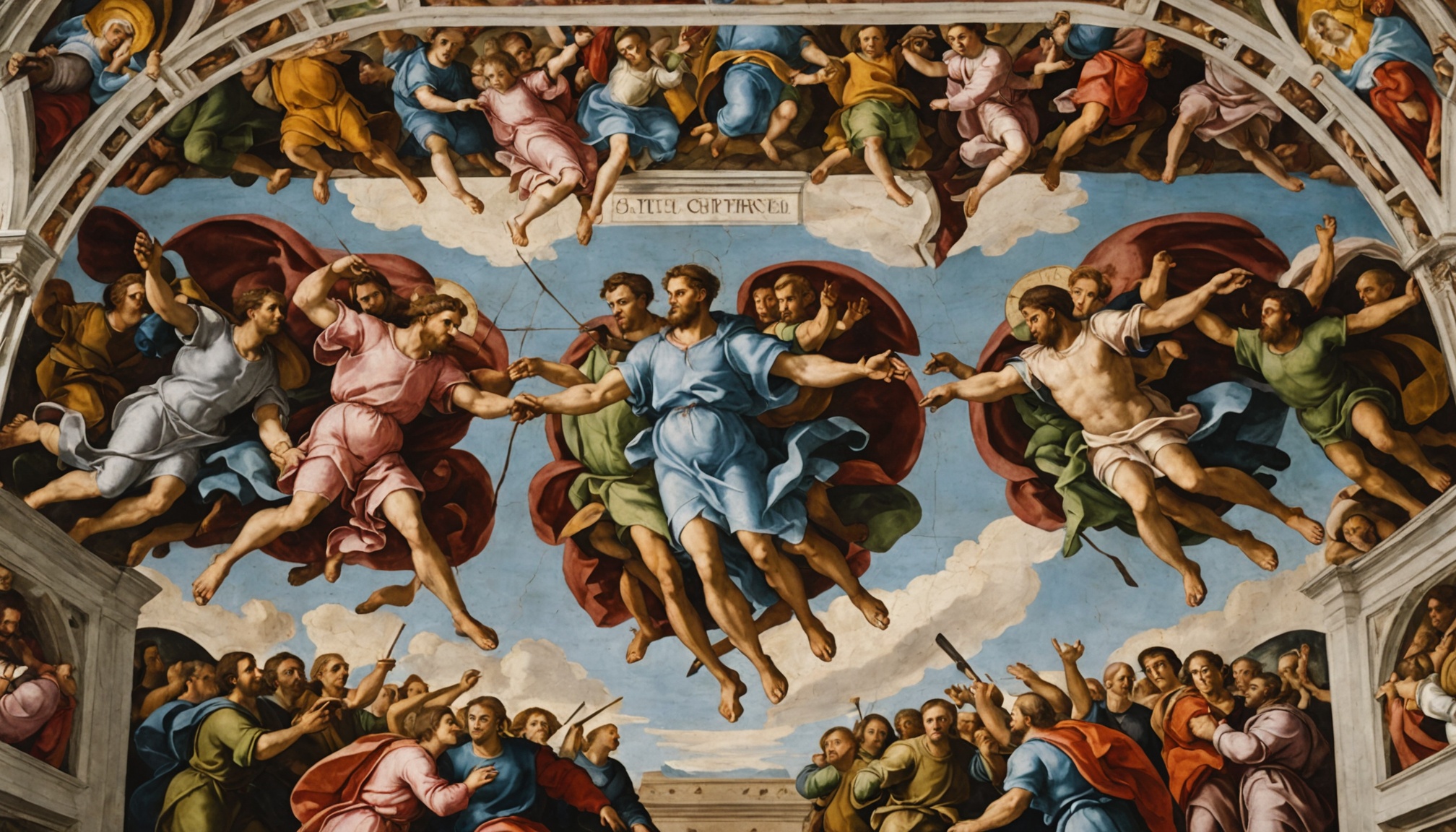If you’ve ever dreamed of witnessing Michelangelo’s masterpiece in person, now is the time. The Sistine Chapel, with its breathtaking frescoes and rich history, offers an unparalleled glimpse into Renaissance artistry. Don’t miss your chance to marvel at this iconic landmark—secure your tickets for an unforgettable experience that blends beauty and spirituality. Each visit promises not just a view, but a deep connection to art that has stood the test of time.
Introduction to the Sistine Chapel
Nestled within the Vatican Museums in Vatican City, the Sistine Chapel stands as a timeless masterpiece of art and spirituality. Revered globally for its stunning frescoes, particularly Michelangelo’s ceiling and the iconic “Last Judgement,” this attraction represents a pinnacle of Renaissance artistry and religious significance. An essential part of any Vatican City visit, the Sistine Chapel is accessible only through the Vatican Museums, requiring careful planning to ensure a smooth experience. As ticket availability can quickly diminish due to high demand, it’s important to find out if you need tickets for the sistine chapel yourself in advance to guarantee entry.
Avez-vous vu cela : Unlock the full potential of your rome adventure through turbopass!
Key Ticketing Information and Tips for Visitors
Tickets to the Sistine Chapel are integrated with those for the Vatican Museums. Prices start at €17 for general admission, €8 for a reduced rate, and an additional €5 for online reservations to secure your visit ahead of time. To enhance your experience, consider a guided tour for in-depth insights on the artworks or even a “skip-the-line” option to bypass potentially long queues. Keep in mind that last-minute purchases at the door are risky, as tickets often sell out, particularly during peak tourist seasons. Travelers looking to maximize their time in Rome might also benefit from comprehensive passes like the Roma Tourist Card, offering access to multiple attractions, including the Vatican Museums, Sistine Chapel, and St. Peter’s Basilica.
Weekday mornings and late afternoons are generally the best time slots to avoid excessive crowds. Sundays, however, present unique challenges: the Vatican Museums and Sistine Chapel open only on the last Sunday of each month, granting free entry. While this may seem appealing, expect large crowds and less opportunity to fully savor the experience. Moreover, dressing modestly—covering shoulders and knees—is a strict requirement, as the Sistine Chapel remains a sacred place of worship.
A découvrir également : Discover rome: 42 must-do activities right now
Enhancing Your First-Time Visit
First-time visitors to the Sistine Chapel may feel overwhelmed navigating the substantial layout of the Vatican Museums, which act as a gateway to the chapel itself. To make the most of this enriching journey, allocate at least two hours. By doing so, you not only admire the Sistine Chapel but also immerse yourself in the cultural and historical artifacts leading up to it.
For an exceptional experience, consider tours such as the Exclusive After Hours tour, offering smaller group access once the crowds thin out. Another popular choice is the Privileged Entrance Vatican Tour, crafted to provide a richer historical context in less congested settings. For families or those on tight schedules, audio guides are a practical way to explore while maintaining flexibility.
Ultimately, visiting the Sistine Chapel is not just a visual encounter but an invitation to step into history and spirituality. Thorough preparation makes all the difference, ensuring you can fully appreciate the unparalleled beauty and significance of this iconic space.
Planning Your Visit to the Sistine Chapel
Optimal Timing for Your Visit
To fully appreciate the awe-inspiring Sistine Chapel, it’s vital to choose the right time for your visit. Early mornings and late afternoons during weekdays are generally quieter, allowing for a more serene environment. Peak tourist seasons, such as spring and summer, typically draw large crowds, leading to longer queues and less personal space within the chapel.
For those seeking to avoid extreme congestion, visiting during the off-peak months of November through February can be an excellent choice. These months tend to still provide access to the vibrant artwork, but with significantly more breathing room. It’s also worth noting that the chapel’s busiest days are Mondays (due to the Vatican Museums being closed on Sundays, apart from the last of each month) and Saturdays when weekend tourists abound.
If you’re eager to dive straight into the Sistine Chapel without delays, booking a timed entry ticket online is indispensable. Reserved times guarantee entry and help sidestep much of the crowd chaos.
Seasonal Considerations and Crowd Management
Planning around seasonal fluxes is an effective strategy for making the most of your visit. From April to October, the warm weather and school holidays bring throngs of visitors to Vatican City, with April and May often considered particularly overwhelming. If visiting during these months, choosing an early slot—ideally before 10 am—can make a noticeable difference in your experience.
Winter months, excluding the festive holiday weeks, offer a far calmer atmosphere. Rainy weather and cooler temperatures often deter tourists, making it an opportune time for art enthusiasts focused on Michelangelo’s creations and the surrounding frescoes.
Another tactic to consider involves crowd management tools. Opting for skip-the-line tickets or joining exclusive guided tours can create a more streamlined journey. Some tours, such as the “Privileged Entrance Vatican Tours,” begin early in the morning, even before public access opens. Alternatively, the after-hours tour offers an intimate encounter with the artwork, as groups are limited in size.
Overview of Guided Tour Options
Enriching your visit with a guided tour can provide an enhanced appreciation of the artwork, history, and meaning of the Sistine Chapel. Professional guides delve into the nuances of Michelangelo’s famed frescoes, dissecting the intricate details of iconic pieces like “The Creation of Adam” and “The Last Judgement.” Some guides even unravel fascinating anecdotes about the challenges Michelangelo faced while painting the ceiling over four relentless years.
Tour options abound. Standard guided tours generally last 2-3 hours, with combinations that also cover highlights of the Vatican Museums. For those preferring a specialized experience, exclusive after-hours tours are available, offering a tranquil setting and often cap their group sizes for added intimacy. Audio guides, on the other hand, provide flexibility to explore at your pace while still benefiting from expert insights.
For a truly comprehensive exploration of Vatican City, some curated packages even include St. Peter’s Basilica and the charming Vatican Gardens. These allow visitors to absorb more of the area’s spiritual and cultural splendors with one seamless booking. Regardless of your choice, guided tours remain an exceptional way to elevate your understanding and admiration of this iconic masterpiece.
Discovering the Art and History of the Sistine Chapel
Key Frescoes and Their Interpretation
The Sistine Chapel is home to some of the most iconic frescoes in the world, transforming its ceiling and walls into a visual masterpiece that continues to captivate visitors. Among the most renowned works is Michelangelo’s “Creation of Adam,” an unparalleled depiction of the biblical moment when God breathes life into Adam. The almost-touching hands of God and Adam evoke a profound connection between the divine and humanity, a symbol that has transcended centuries.
Another significant piece by Michelangelo, “The Last Judgement,” spans the entire altar wall and portrays the second coming of Christ. This dynamic fresco presents an overwhelming vision of salvation and damnation, with intricate details that demand close examination. Over 300 figures, each radiating emotion and movement, illustrate this narrative of final judgment, drawing in observers with its complexity and towering size.
Other artists also left their mark within the chapel. Sandro Botticelli’s “The Punishment of Korah” and “The Temptation of Christ” are vivid interpretations of faith and morality, shedding light on Renaissance biblical storytelling. Meanwhile, Pietro Perugino’s frescos, such as “The Handing of the Keys to Saint Peter,” emphasize papal authority, an underlying theme in the chapel’s overall message.
Architectural Features and Historical Context
Commissioned by Pope Sixtus IV and completed between 1473 and 1481, the Sistine Chapel’s architecture complements its artistic richness. Its simple exterior contrasts sharply with the overwhelming beauty of the interior. The structure was designed to mimic the dimensions of Solomon’s Temple in Jerusalem, giving it a sense of spiritual and historical continuity.
However, the true transformation of the chapel came during the early 1500s when Pope Julius II appointed Michelangelo to paint the ceiling. Michelangelo, primarily a sculptor, initially resisted this monumental task, but his innovative approach to creating a three-dimensional effect on a flat surface ultimately redefined art itself. His use of fresco technique and mastery of human anatomy remain unmatched, setting a precedent for generations of artists to follow.
The Sistine Chapel also has a critical role in the history of Catholicism. It serves as the site of the Papal Conclave, where cardinals gather in secrecy to elect a new pope. The chapel’s artistic splendor underscores its significance as a spiritual and political epicenter.
Understanding the Cultural Impact of the Chapel
The Sistine Chapel’s influence surpasses its religious importance. It is a beacon of Renaissance art and innovation, symbolizing humanity’s ability to merge faith with creativity. Michelangelo’s ceiling frescoes alone have inspired countless adaptations in modern culture, from academic discourse to contemporary media.
Beyond its artistic value, the chapel embodies a cultural legacy tied deeply to the Vatican’s role in history. The narratives depicted on its walls and ceiling remind viewers of the moral and spiritual lessons that have shaped Western thought. Moreover, its ongoing conservation efforts highlight humanity’s commitment to preserving such monuments for future generations.
Today, the Sistine Chapel draws millions of visitors annually, each seeking a glimpse of its timeless beauty. Its art, architecture, and history continue to bridge the past and present, inviting everyone to experience its profound connection to both the divine and the human story.





